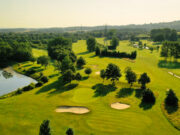
Bryson DeChambeau could be one of the players who can overpower the iconic course.
The first Masters to be staged in November could also produce the first debutant winner since 1979, given the quality of a number of players making their first trip to Augusta National.
But could it also be the final straw in golf’s long-running distance debate as US Open champion Bryson DeChambeau looks to overpower one of the most iconic courses in the world?
DeChambeau’s decision to “bulk up” in order to hit the ball further and then deal with the consequences was meant to be negated by the narrow fairways and thick rough at a typical US Open venue liked Winged Foot, but he proved the doubters wrong with an emphatic six-shot triumph.
For his two events so far in the 2020-21 PGA Tour season, DeChambeau is ranked first in driving distance with an average of 344.4 yards and also first in scoring average (66.7), but finds the fairway just 52.68 per cent of the time to lie a lowly 205th in driving accuracy.
And it is that disparity which is fuelling the distance debate in the game. If being in the rough is not a sufficient punishment for inaccuracy, then why not simply hit the ball as far as possible and take your chances?
“For the most part, if you’re able to hit it far enough up there, I feel like (with) wedges you can get it out pretty easy and run some stuff up,” as DeChambeau surmised correctly during the US Open.
If you can’t beat him, join him, may now be the attitude of some of DeChambeau’s rivals, with Rory McIlroy and Tony Finau among those to post evidence on social media of the ball speed they can achieve when seemingly hitting flat out.
McIlroy achieved 186mph and 340 yards of carry on his launch monitor and Finau managed 206mph, only for DeChambeau to then reach an incredible 211mph on a drive which flew 403.1 yards in the air.
“Not even the 48in driver,” DeChambeau wrote on his social media post, a reference to the club – the longest allowed – he is currently testing with a view to putting it in his bag at Augusta.

It is worth noting that DeChambeau’s 403-yard carry was achieved downwind and repeatedly producing such prodigious distances will not be easy, but at 350 yards the third green will be within reach and DeChambeau could face just two approach shots over 150 yards.
Ahead of last year’s Masters, tournament officials said they would wait to see if any action was taken by the game’s governing bodies before deciding whether to lengthen the 13th hole after buying land from the adjacent Augusta Country Club.
Club chairman Fred Ridley admitted the intended “momentous decision” about going for the par-five’s green in two, had become largely irrelevant, but was hesitant to make changes to the “sacred place” that is Amen Corner.
Even a club as wealthy and powerful as Augusta National cannot simply keep extending their course indefinitely, while venues such as the Old Course at St Andrews are already at their limit.
Trees, water hazards and treacherous greens might yet prevent Augusta National from being overpowered, but when St Andrews hosts the 150th Open Championship in 2022 it could be a different story.
Former US Open champion Graeme McDowell said: “If you think about St Andrews – and I don’t want to say just Bryson because there’s going to be another 10 Brysons in the next 12 months – what could he do to St Andrews on a calm day?
“He could drive 10, maybe 12 greens. He could make it silly.”
Golf’s governing bodies want to break the “ever-increasing cycle of hitting
distance” and although the next stage of their Distance Insights Project (DIP) has been delayed until March 2021 due to the Covid-19 pandemic, they will be watching events in Augusta closely.























